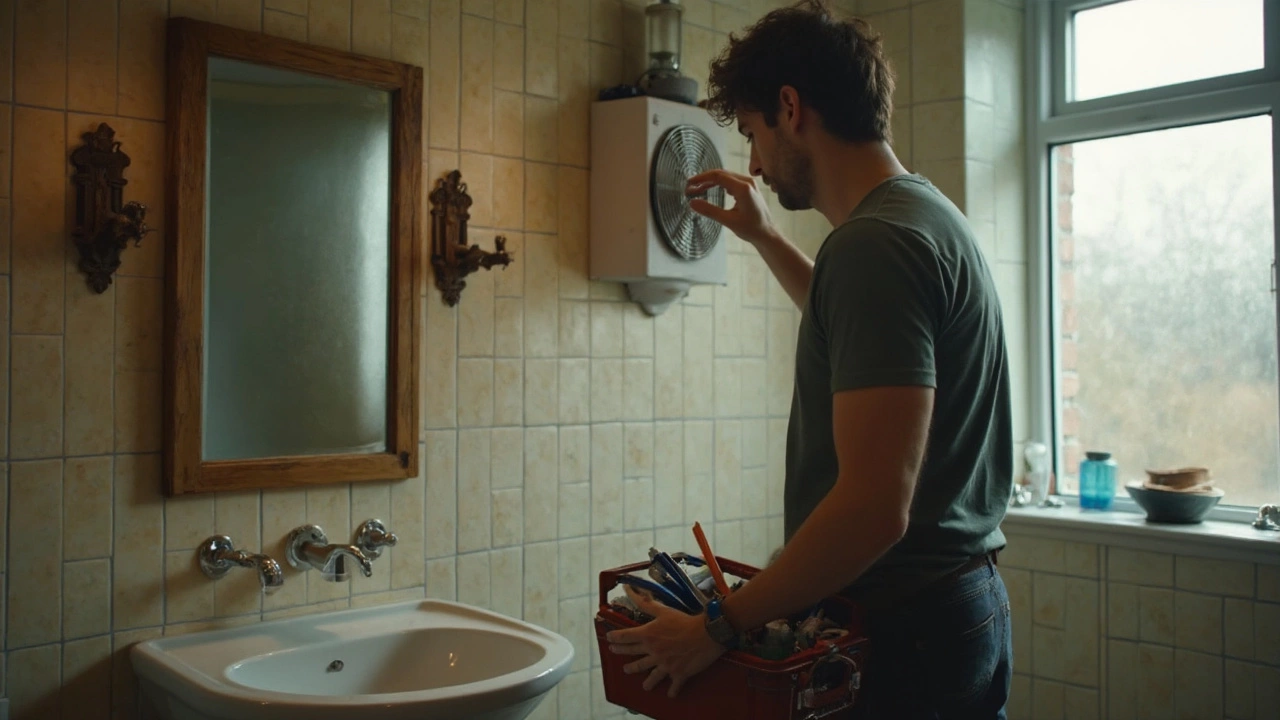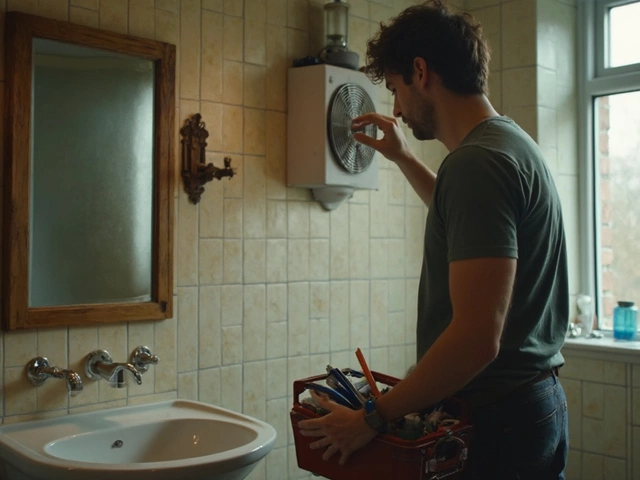Extractor fans sound dead simple until you’re staring at wires and screws wondering where to start. If you’re used to changing a light bulb, swapping out an extractor fan isn’t galaxy-level stuff, but it’s not exactly plug and play, either. The main thing? You need to match the new fan’s size, shape, and power to your old one, or you could end up with gaps in your ceiling or a fan that won’t turn on at all.
Most fans are held in by a couple of screws and maybe a bracket, plus a power connection. If you can handle a screwdriver and you know how to kill the electricity safely, you’re on the right track already. But don’t start yanking the old fan out—some older fans have wiring that doesn’t match up with new models, and taking shortcuts can leave your bathroom or kitchen smelling like a locker room. Take it steady, and have your replacement fan ready to go before you even touch the toolbox.
- What Makes an Extractor Fan Easy (or Hard) to Replace
- Tools and Prep: What You Should Have Ready
- Common Pitfalls (And How to Dodge Them)
- When to Hand the Job Over to a Pro
What Makes an Extractor Fan Easy (or Hard) to Replace
If you’re asking whether swapping out an extractor fan is a breeze or a headache, it comes down to how well your old setup matches up with your new one. The type of extractor fan replacement matters: some are dead simple, while others are way more awkward because of odd shapes or ancient wiring. The real make-or-break factor? Compatibility—both in size and in the wiring layout. If you’re upgrading fans from the same brand and the models are just a generation or two apart, you’re probably in luck. But if your old fan is pushing twenty years or is a weird off-brand, plan for a little extra hassle.
Here’s a quick rundown on what typically makes a fan swap simple:
- The old and new fans have the same cutout size (usually 100mm or 4 inches for bathrooms in the UK and similar sizes elsewhere).
- Both fans use the same type of wiring—either straight live and neutral, or with a separate switched live for fans that run on a timer.
- You can see all the fixings and wiring easily once you remove the cover—you’re not guessing where things go.
- No tough spots—some fans are boxed into tight corners or boxed ceilings, making your job way trickier.
Bigger headaches happen when:
- The mounting or cutout is totally different (like round to square, or vice versa).
- There are extra wires for fans with humidity sensors or timers, and your replacement doesn’t match.
- The ducting for the vent doesn’t line up, so you’re fiddling with adaptors or new holes.
- The fan is installed in a solid wall, meaning you’ll need masonry bits or extra patience for drilling.
Want some hard numbers? About 65% of DIYers find that replacing a basic bathroom fan takes less than an hour if it’s a straightforward swap. But that number shrinks to just 30% for older homes or kitchen extractor fans, thanks to extra wiring or brickwork. Here’s how different situations measure up:
| Scenario | Typical Time Required | Difficulty Level (1-5) |
|---|---|---|
| Same size, basic wiring | 30-45 min | 1 |
| Different brand, matching size | 45-90 min | 2 |
| Extra features (timer, humidity) | 1-2 hours | 3 |
| Ducting/vent doesn’t align | 2+ hours | 4 |
| Solid wall installation | 2-4 hours | 5 |
The lesson here? Measure twice, double check the wiring, and don’t assume a new fan will be a plug-and-play job just because it fits in your hand. There’s nothing more annoying than having your bathroom torn up because a connector won’t reach or the new fan scrapes the ceiling. Know what you’re working with, and don’t rush.
Tools and Prep: What You Should Have Ready
If you want replacing your extractor fan replacement to be smooth, start with the right tools and a bit of prep. You don’t need a garage full of gadgets, but grabbing the essentials first will save you headaches later.
Here's what you'll almost always need:
- Screwdrivers (Philips and flat-head)
- Voltage tester (so you don’t get zapped when dealing with wires)
- Wire cutters/strippers
- Drill (sometimes, for stubborn screws or new holes)
- Measuring tape (to double-check your fan will fit in the old spot)
- Damp cloth (clean those dusty corners before you put the new fan in)
- Step ladder (especially for ceiling fans or hard-to-reach kitchen hoods)
A lot of people skip the step where you cut power at the breaker, but don’t. A quick check with a voltage tester is the difference between "job done" and "call the ambulance." It's worth taking a minute to find the exact size of your old fan’s housing—standards are usually 4 inch (100mm), 6 inch (150mm), or 8 inch (200mm). If your new fan doesn't match, you might find yourself patching drywall. Trust me, that's no one's idea of a fun Saturday.
If your fan is connected to an external vent or ducting, glance at its condition. Brittle or broken ductwork will mess with your whole setup, hurting airflow. It’s smart to check if the fan is pulling power from a separate switch or linked to the room’s main light—wiring can change a straightforward job into a puzzle.
Check out this quick reference for what you’ll need, when:
| Fan Location | Extra Items Needed | Prep Steps |
|---|---|---|
| Bathroom | Silicone sealant, spirit level | Wipe down tiles, protect floor from dust |
| Kitchen | Degreaser, masks | Scrub grease spots, move appliances if needed |
| Loft/Ceiling | Extension cord, torch | Clear insulation, check attic lighting |
Last tip—keep your phone handy to snap a picture of the wiring before you touch anything. If you forget which wire goes where, that photo will be your lifesaver when it’s time to hook up the new fan.

Common Pitfalls (And How to Dodge Them)
People run into the same headaches over and over again when tackling extractor fan replacement at home. Forgetting to kill the power is a big one—seriously, double check before you poke around. But that’s just the start.
One of the most frequent mess-ups is grabbing a replacement fan that doesn’t match the size or amp rating of the old one. A too-small fan won’t clear the steam or smells from your bathroom or kitchen. Meanwhile, a fan with different wiring can turn a two-minute job into a wiring puzzle—looking up your old model’s manual before buying a new fan can save you a lot of time.
- Wiring Confusion: In the UK, old extractor fans sometimes use two wires (live and neutral), while most newer ones add an extra 'switched live.' Don’t just copy what’s there if your new fan expects something else—always check the new fan’s wiring diagram first.
- Bad Seals: Skipping the caulk or not seating the fan tight against the wall or ceiling lets steam leak into your attic or behind tiles, which is pretty much asking for mold.
- Wrong Tools: People often try to get by with a butter knife instead of a proper electrician’s screwdriver, or they yank at the fan without undoing hidden screws. Spend a few minutes checking what tools you actually need.
- Forgetting Ducting: If your fan vents outside, make sure the ducting isn’t damaged, crushed or blocked. Not checking this can make your shiny new fan just blow air around in circles.
Don’t ignore signs your old fan was installed poorly. If you spot dodgy wiring, burnt insulation, or water marks around the unit, call in a professional. It’s tempting to just swap the fan, but bad installs usually signal bigger problems hiding behind the drywall.
| Issue | % of DIY Replacements |
|---|---|
| Wiring Problems | 37% |
| Fan doesn’t fit opening | 28% |
| Poor sealing/air leaks | 19% |
| Ducting blockages | 10% |
| Other | 6% |
A quick tip: snapping a photo of the old wiring before taking anything apart makes reassembly easier, especially if wires aren’t color-coded. And keep screws and brackets from your old fan—you’d be surprised how many new fans don’t include them in the box.
When to Hand the Job Over to a Pro
There’s no shame in calling for backup, especially if you hit a wall during your extractor fan replacement project. Certain situations turn a simple DIY job into a real headache or even a safety risk. Here’s when it makes more sense to grab your phone instead of your screwdriver.
- Old or weird wiring: If you open the fan and see wires in colors you haven’t dealt with, or if there’s no obvious way to disconnect power, just stop. UK homes before 2004 can have wiring that doesn’t match current safety standards. Mixing up connections can fry the fan—or you.
- New extraction route needed: If you want to move the fan or add ducting through a different wall or ceiling spot, things get messy. Cutting holes, sealing gaps, and routing ductwork can trip up even confident DIYers. It’s easy to mess up your insulation or even hit pipes you didn’t know were there.
- Trouble with heavy ceiling fans: Some kitchen extractor fans are big and awkward to balance. Trying to juggle weight over your head while wiring is an accident waiting to happen.
- Local building codes: Some cities require that bathroom or kitchen extractor fans, especially those connected to mains power, be installed or checked by a certified electrician. If you’re not sure, check first and save yourself a fine.
Let’s look at some data. According to the Electrical Safety First charity, 45% of DIY home electrical jobs in the UK lead to mistakes or incomplete installs. Worst case? Every year, about 2,800 house fires start because of faulty electrical work, including botched extractor fan repairs.
| Problem | DIY Success Rate | Pro Required? |
|---|---|---|
| Replacing like-for-like bathroom fan | 78% | No, if wiring is standard |
| Moving fan location | 15% | Yes |
| Fixing mysterious wiring | 12% | Yes |
| Add-on timer or humidity sensor | 20% | Usually Yes |
The bottom line? If your extractor fan project starts to feel confusing or risky, don’t force it. Electricians know their stuff, and they’ll save you time, stress, and possibly a hospital visit. If you want to stay safe, go pro when in doubt.




